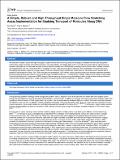A Simple, Robust, and High Throughput Single Molecule Flow Stretching Assay Implementation for Studying Transport of Molecules Along DNA
Author(s)
Xiong, Kan; Blainey, Paul C
Downloadjove-protocol-55923-a-simple-robust-high-throughput-single-molecule-flow-stretching-assay.pdf (314.0Kb)
PUBLISHER_CC
Publisher with Creative Commons License
Creative Commons Attribution
Terms of use
Metadata
Show full item recordAbstract
We describe a simple, robust and high throughput single molecule flow-stretching assay for studying 1D diffusion of molecules along DNA. In this assay, glass coverslips are functionalized in a one-step reaction with silane-PEG-biotin. Flow cells are constructed by sandwiching an adhesive tape with pre-cut channels between a functionalized coverslip and a PDMS slab containing inlet and outlet holes. Multiple channels are integrated into one flow cell and the flow of reagents into each channel can be fully automated, which significantly increases the assay throughput and reduces hands-on time per assay. Inside each channel, biotin-λ-DNAs are immobilized on the surface and a laminar flow is applied to flow-stretch the DNAs. The DNA molecules are stretched to > 80% of their contour length and serve as spatially extended templates for studying the binding and transport activity of fluorescently labeled molecules. The trajectories of single molecules are tracked by time-lapse Total Internal Reflection Fluorescence (TIRF) imaging. Raw images are analyzed using streamlined custom single particle tracking software to automatically identify trajectories of single molecules diffusing along DNA and estimate their 1D diffusion constants.
Date issued
2017-10Department
Massachusetts Institute of Technology. Department of Biological EngineeringJournal
Journal of Visualized Experiments
Publisher
MyJove Corporation
Citation
Xiong, Kan and Paul C. Blainey. “A Simple, Robust, and High Throughput Single Molecule Flow Stretching Assay Implementation for Studying Transport of Molecules Along DNA.” Journal of Visualized Experiments 128 (October 2017): e55923 © 2017 Journal of Visualized Experiments
ISSN
1940-087X